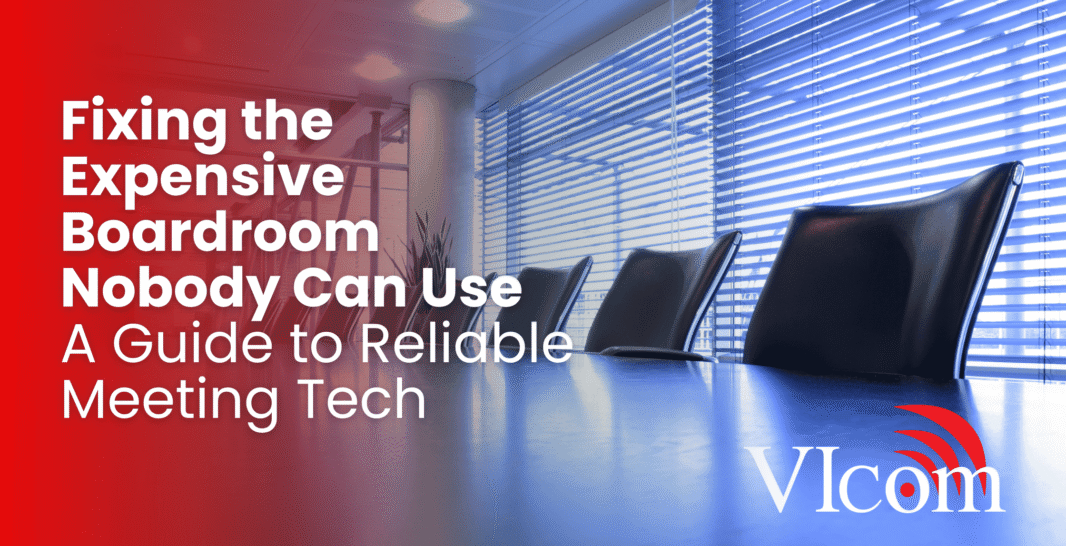The scene is uncomfortably familiar. Your most important executives are gathered for a critical video call. The client is waiting. And nothing works. The screen is blank, the remote audio won’t connect, and a six-figure technology investment has just become the single point of failure for a high-stakes decision.
This isn’t just a momentary inconvenience; it’s a direct drain on the business. Every minute spent wrestling with cables and confusing interfaces is executive time wasted. Every failed meeting erodes trust in the IT department and undermines future technology initiatives. The result is a terrible return on investment for what should be one of your organization’s most valuable assets.
This article provides a strategic framework to move beyond reactive fixes and permanently solve the problem of the unreliable, complex meeting room.
A Diagnosis of the “Million-Dollar Coatrack”
When a state-of-the-art boardroom becomes a space people actively avoid, it’s what we call a “Million-Dollar Coatrack”—an expensive, underutilized asset. This failure isn’t typically due to a single broken piece of hardware. It’s a symptom of a deeper, more strategic misalignment.
The root cause is a system designed for features, not for human workflow. The technology was likely procured with a checklist of capabilities—”Can it do 4K? Does it have three cameras?”—instead of asking the most important question: “Can a first-time user start a meeting in under 60 seconds without help?”
This project-based mindset ignores the end-user experience and lacks a long-term plan for support and usability. The consequences are severe and cascading:
- Constant Firefighting: IT support is perpetually pulled away from strategic projects to troubleshoot basic connectivity issues. Research shows that around 28% of meeting attendees worry about incompatible equipment, turning IT into on-call AV support.
- Eroded User Trust: When users lose faith in the boardroom technology, they lose faith in all technology. They revert to old, inefficient methods, and the adoption of valuable new tools plummets across the organization.
- Negative ROI: A system that is difficult or unreliable will not be used. Without user adoption, the ROI on your investment is effectively zero, or even negative when factoring in lost productivity and support costs.
Reliability by Design
The solution is to shift your approach from buying technology to architecting experiences. VIcom’s “Reliability by Design” methodology moves the focus from what the room can do to how people actually work. It’s a philosophy built on two core pillars that directly address the root causes of failure.
-
We Engineer Trust: The primary goal is to create a predictable, simple, and repeatable user experience. Trust is built when technology “just works” every single time. This means engineering a “one-touch join” environment where the user’s focus remains on the meeting, not the technology. Intuitive, consistent interfaces across all meeting spaces eliminate the learning curve and empower users to be self-sufficient.
-
Adoption is the Only True ROI: A technology investment is only successful if it is fully embraced by its users. By engineering for trust and simplicity, we remove the primary barriers to adoption. When systems are effortless, usage naturally increases. This drives the productivity gains, travel cost reductions, and collaborative efficiencies that deliver a measurable return on your investment.
This strategic framework prioritizes outcomes over features, ensuring the technology serves the business, not the other way around.
A 5-Minute Meeting Room Audit
How does your current environment stack up? Use this simple checklist to quickly assess the reliability and user-friendliness of your most important meeting spaces.
- The 60-Second Challenge: Can a first-time guest walk into the room and successfully launch a video conference in under one minute, without needing printed instructions or calling for help?
- Visible Support: If a problem does occur, is the support contact number or helpdesk information clearly and permanently displayed in a prominent location?
- Cable & Connector Clarity: Are all user-facing cables (if any) and connection points clearly and professionally labeled with their function (e.g., “Guest Laptop – HDMI”)?
- Hybrid Equity Check: During a test call, can remote participants clearly hear a question asked from the back of the room without complex audio adjustments? Is the video clear for both in-room and remote attendees?
- Proactive Monitoring: Is there a centralized system in place that allows your IT team to proactively monitor the room’s health, detect offline devices, and troubleshoot issues before a user reports a problem?
If you answered “no” to any of these questions, you have an opportunity to significantly improve the reliability and value of your meeting spaces.
From Technical Debt to Strategic Asset
Reliable meeting rooms are the bedrock of a modern collaboration strategy. They are not a collection of hardware, but a carefully orchestrated ecosystem of technology, process, and user-centric design. Achieving this level of performance requires more than a simple hardware refresh; it demands a partner who understands how to architect human-centric experiences, bridge the gap between AV and IT, and manage technology as a long-term program. As a 100% employee-owned company, every VIcom expert is personally invested in transforming your technological liabilities into strategic assets that drive your business forward.
Ready to transform your collaboration strategy? Schedule your free consultation with a VIcom expert today using the form below.

